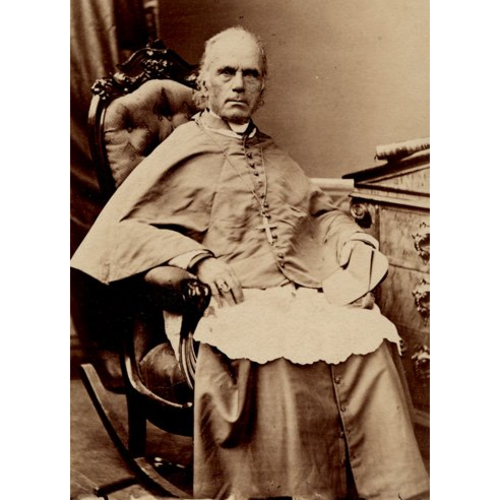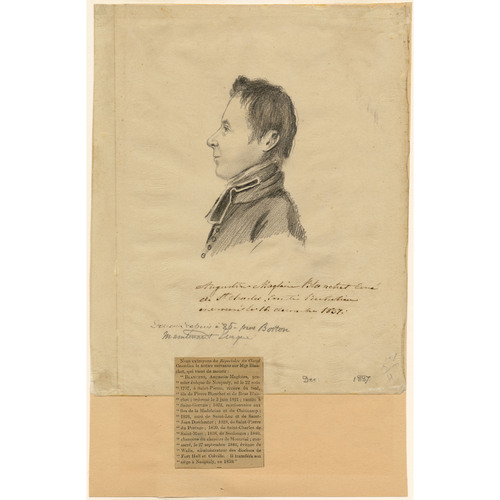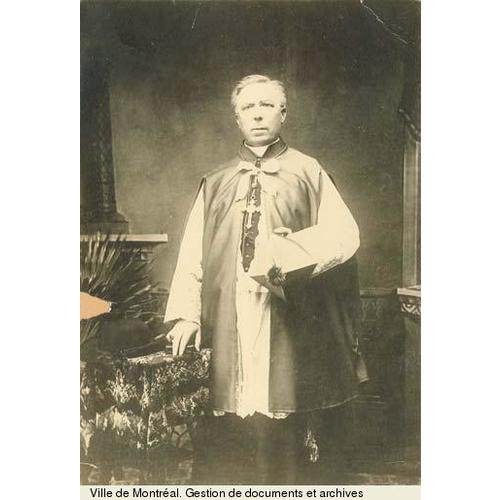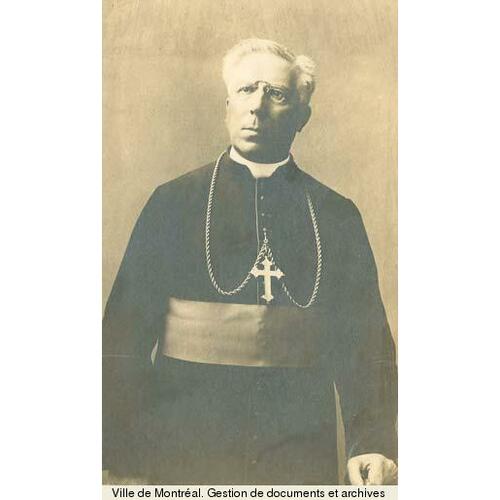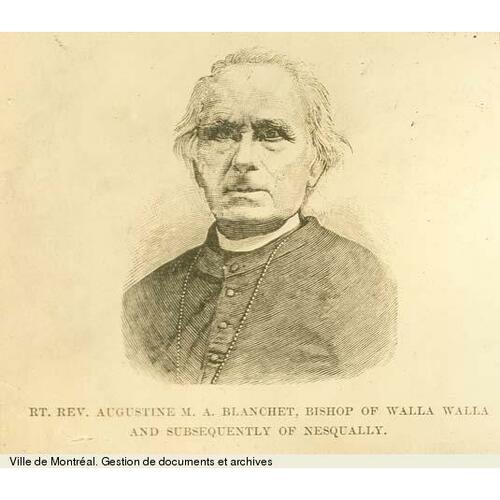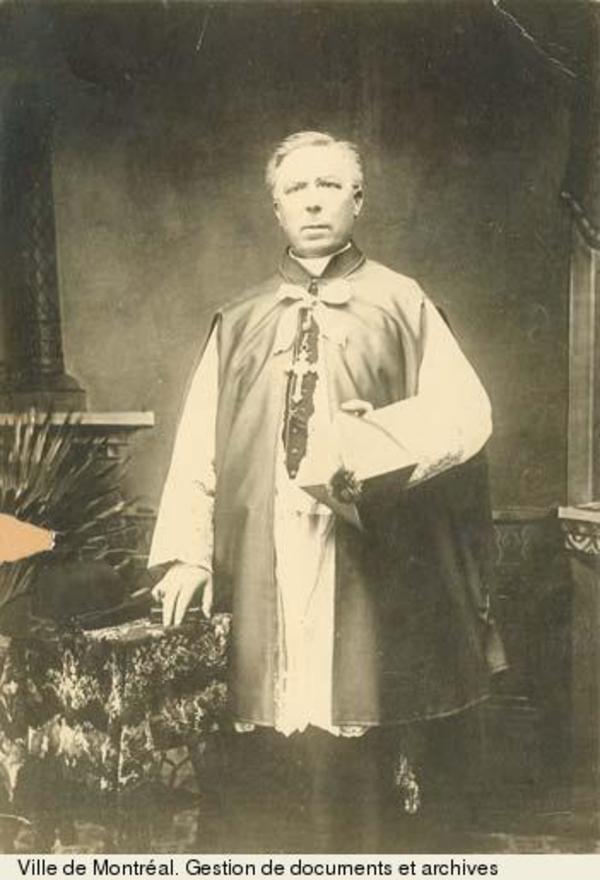
Source: Link
BLANCHET (Blanchette), AUGUSTIN-MAGLOIRE, Roman Catholic priest, missionary, and bishop; b. 22 Aug. 1797 at Saint-Pierre-Montmagny, Lower Canada, son of Pierre and Marie-Rose Blanchette; d. 25 Feb. 1887 at Vancouver (Wash.).
Augustin-Magloire Blanchet followed in the footsteps of his older brother, François-Norbert. After studying Latin in his native parish, he enrolled at the Petit Séminaire, and then at the Grand Séminaire de Québec. Ordained priest on 3 June 1821, he acquired his early experience as a curate at Saint-Gervais (1821–22), and then as a missionary at Chéticarnp, N.S., and on the Îles de la Madeleine (1822–26) . He was recalled from there to take important posts as parish priest in the Montreal region: at Saint-Luc on the Richelieu river, also serving Saint-Jean l’Évangéliste (1826–28); at Saint-Pierre-du-Portage (Assomption-de-la-Sainte-Vierge) (1828–30); and at Saint-Charles in Saint-Charles-sur-Richelieu (1830–38), ministering at Saint-Marc as well (1830–32). After considering entering the Séminaire de Saint-Hyacinthe, a proposal which caused strained relations with Bishop Jean-Jacques Lartigue*, Blanchet finally regained the confidence of the bishop, who appointed him an archpriest in 1835 and entrusted him with several important missions.
In 1837 political events in the Richelieu valley forced Blanchet, whose parish of Saint-Charles was the stronghold of the local Patriotes, to make a number of difficult choices. He acknowledged that the grievances of the party of Louis-Joseph Papineau* were justified, and, though he declined to engage actively in politics, he warned the governor, Lord Gosford [Acheson*], in a letter dated 9 Nov. 1837 that he might be misinformed, and that “if the government desires the happiness of the country, it should lose no time in complying with the just requests of the people.” He added that “one could no longer count on the clergy to check the popular movement in the region,” for “the shepherds cannot part company with their flocks.” The morning of the battle at Saint-Charles, on 25 November, Blanchet, who was opposed to violence and bloodshed, went to the camp of the Patriotes, most of whom were his parishioners; he took the opportunity to bless them and get them to say prayers. His action was interpreted in varying ways: one Patriote, Siméon Marchessault*, saw in it only a desire to give a general absolution, but another, Simon Talon, ditL’Espérance, asserted that “the object of Messire Blanchet’s prayer was to encourage the habitants to fight.”
The British authorities and the supporters of the government leaned towards the latter interpretation. Blanchet was arrested for high treason and taken to Montreal where he was imprisoned on 16 December. After an inquiry conducted on the spot and a long explanation from Blanchet, the bishops of Montreal and Quebec, anxious not to compromise the clergy, gave their version of the events: Bishop Lartigue concluded that the parish priest had merely been “a little weak and imprudent,” and Bishop Joseph Signay* considered that he had acted out of fear of the Patriotes. Consequently they both did all in their power, by speaking and writing, to intercede on his behalf with Gosford and even with Sir John Colborne*, the commander-in-chief of the forces in the two Canadas. Thanks to their efforts Blanchet was set free on 31 March 1838 on £1,000 bail.
When he left prison Blanchet became parish priest of Saint-Joseph, Les Cèdres, replacing his brother François-Norbert who was leaving for Oregon missions. Augustin-Magloire remained at Saint-Joseph until 1842 when he was summoned to the diocese of Montreal; he became a titular canon in 1844. Two years later a decision from Rome reunited the two Blanchet brothers. It entrusted Augustin-Magloire with the direction of the diocese of Walla Walla, in the section of the Oregon Territory that is now the state of Washington, while his brother became archbishop of Oregon City (Oreg.). The new bishop was consecrated in the cathedral at Montreal on 27 Sept. 1846 and set out for Oregon on 4 March 1847. On 5 September, after a long, exhausting journey, Augustin-Magloire reached his destination and at the beginning of October his travelling companions, including four Oblate missionaries who had stopped at Fort Hall (Idaho), finally arrived also. At the Indians’ request Blanchet and Jean-Baptiste-Abraham Brouillet, his vicar general, decided to take up residence among the Cayuses, some 25 miles from Walla Walla.
Tragic events obliged them to change their plans. A few days after the arrival of the Oblate missionaries, the Cayuses killed the Protestant missionaries and several settlers at Waiilatpu (Idaho). Bishop Blanchet himself met the Indian chiefs and pleaded the cause of those prisoners who had been saved thanks to an intervention by Abbé Brouillet. These actions did not placate the Americans, who accused the two Catholic missionaries of having instigated the attack, while the Cayuses received the exhortations and warnings with bad grace. In these circumstances Blanchet deemed it preferable to withdraw to St Paul (Oreg.), in the Willamette valley, leaving Brouillet behind; the latter remained until American soldiers arrived to avenge their fellow citizens in February 1848.
In 1850, at the request of the three bishops of Oregon, Rome created the diocese of Nesqually (later the diocese of Seattle, Washington) and transferred Augustin-Magloire to it; three years later the old diocese of Walla Walla was eliminated and part of its territory – Walla Walla and the lands of the Cayuse and the Dalles Indians – was annexed to the new diocese. In this expanse of nearly 100,000 square miles Blanchet laboured for more than 25 years, setting up missions, consecrating churches, instructing the faithful, and administering the sacraments, as did all the missionaries who worked with him. He also made a contribution to the first two provincial councils in Oregon City, in 1848 and 1861, and took part in the plenary councils at Baltimore, Md, in 1852 and 1866. Moreover, the 1852 council gave him the opportunity to visit Mexico, South America, and Europe, in order to collect funds for his diocese; he returned in 1856 with a few Sisters of Charity of Providence (Sisters of Providence).
An old man worn out by toil and illness, Augustin-Magloire Blanchet resigned from his post and became bishop of Ibora in partibus infidelium on 23 Dec. 1879; he remained in the diocese of Nesqually until his death in February 1887.
AAQ, 210 A, XI–XVIII; 26 CP, VI. ACAM, 420.041; RLB, 1; RLL, 8–9. ANQ-Q, QBC 25, Événements de 1837–1838, nos.292, 844. AP, Saint-Pierre-de-la-Rivière-du-Sud (Saint-Pierre-Montmagny), Reg. des baptêmes, mariages et sépultures, 22 août 1797. “Le curé de St-Charles, en 1837, se disculpe de trahison,” François Beaudin, édit., RHAF, 22 (1968–69): 441–48. Rapport sur les missions du diocese de Québec . . . (Québec), no.7 (juill. 1847): 1–34; no.8 (avril 1849): 1–33; no.9 (mars 1851): 1–28, 39–66. L’Ami du peuple, de l’ordre et des lois (Montréal), 20 déc. 1837. Mélanges religieux (Montréal), janv., août 1848. [O. B. Corrigan], “Chronology of the Catholic hierarchy of the United States,” Catholic Hist. Rev. (Washington), 1 (1915–16): 367–89. C. H. Carey, A general history of Oregon prior to 1861 (2v., Portland, Oreg., 1935). Richard Chabot, Le curé de campagne et la contestation locale au Québec (de 1791 aux troubles de 1837–38): la querelle des écoles, l’affaire des fabriques et le problème des insurrections de 1837–38(Montréal, 1975). E. V. O’Hara, Pioneer Catholic history of Oregon (Portland, 1911). Théophile Ortolan, Cent ans d’apostolat dans les deux hémisphères: les Oblats de Marie Immaculée durant le premier siècle de leur existence (4v., Paris, 1914–32), II. Sidney Warren, Farthest frontier; the Pacific northwest (New York, 1949; repr. Port Washington, N.Y., 1970).
Cite This Article
Nive Voisine, “BLANCHET (Blanchette), AUGUSTIN-MAGLOIRE,” in Dictionary of Canadian Biography, vol. 11, University of Toronto/Université Laval, 2003–, accessed December 12, 2025, https://www.biographi.ca/en/bio/blanchet_augustin_magloire_11E.html.
The citation above shows the format for footnotes and endnotes according to the Chicago manual of style (16th edition). Information to be used in other citation formats:
| Permalink: | https://www.biographi.ca/en/bio/blanchet_augustin_magloire_11E.html |
| Author of Article: | Nive Voisine |
| Title of Article: | BLANCHET (Blanchette), AUGUSTIN-MAGLOIRE |
| Publication Name: | Dictionary of Canadian Biography, vol. 11 |
| Publisher: | University of Toronto/Université Laval |
| Year of publication: | 1982 |
| Year of revision: | 1982 |
| Access Date: | December 12, 2025 |


